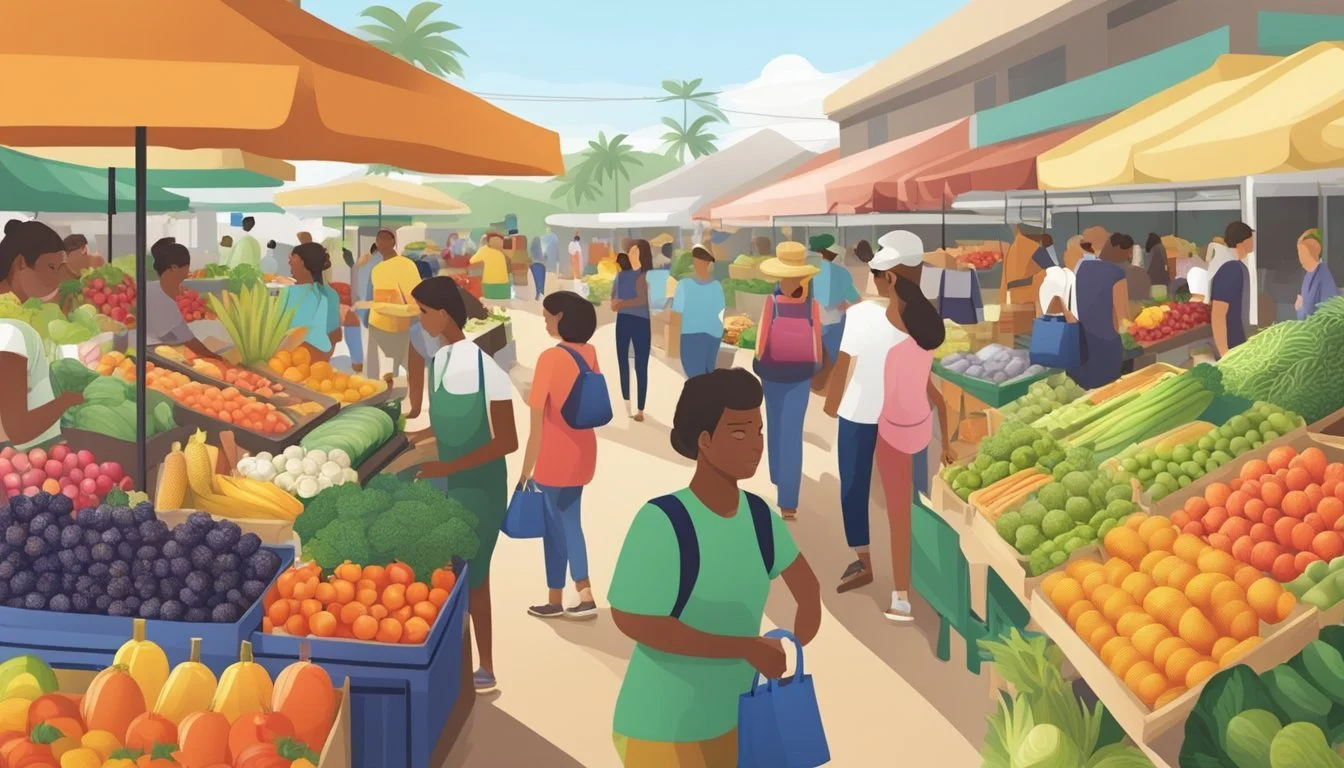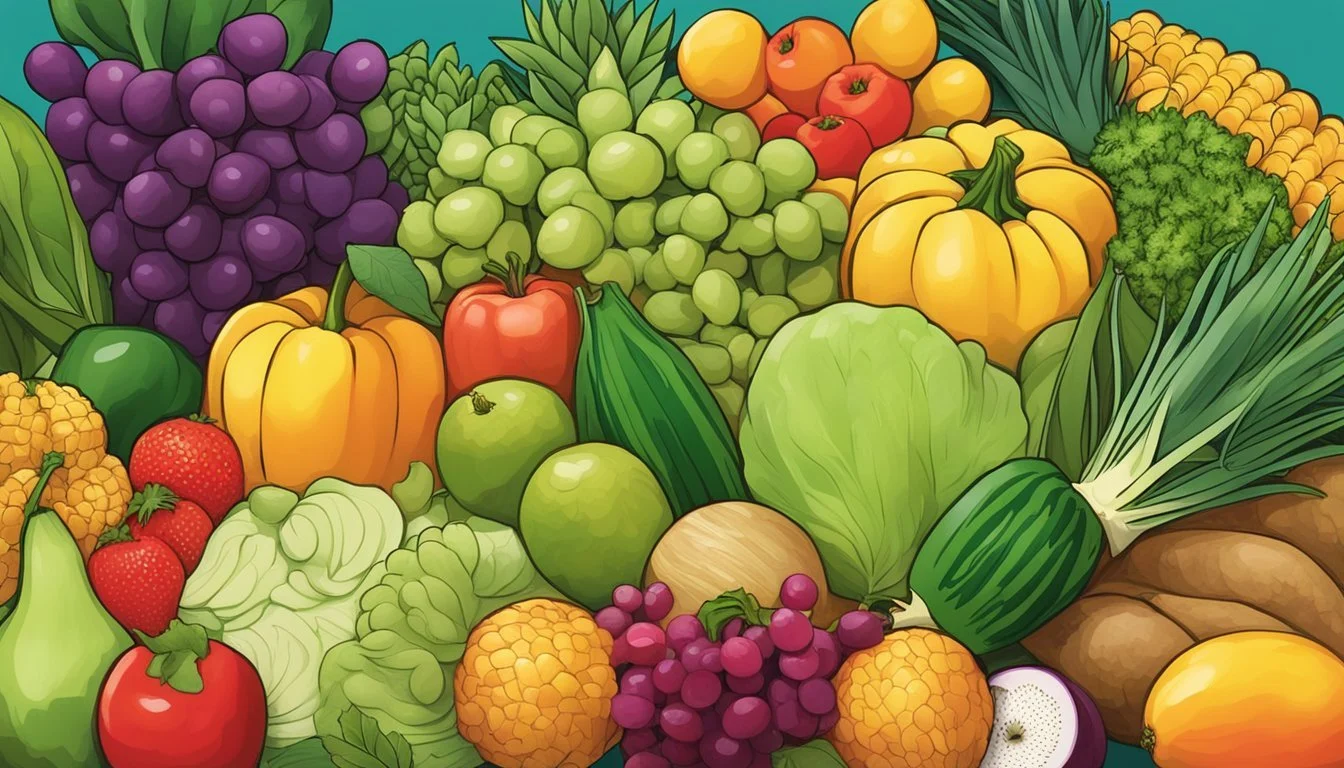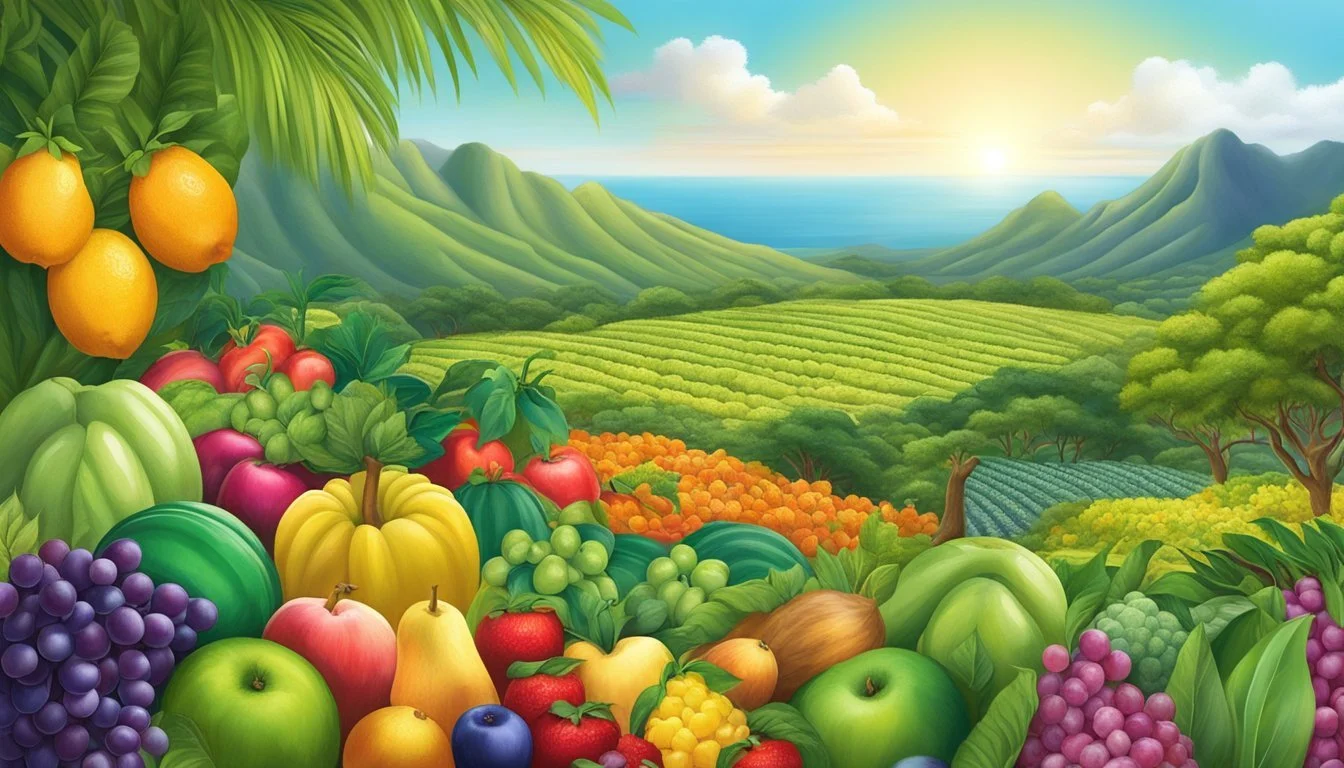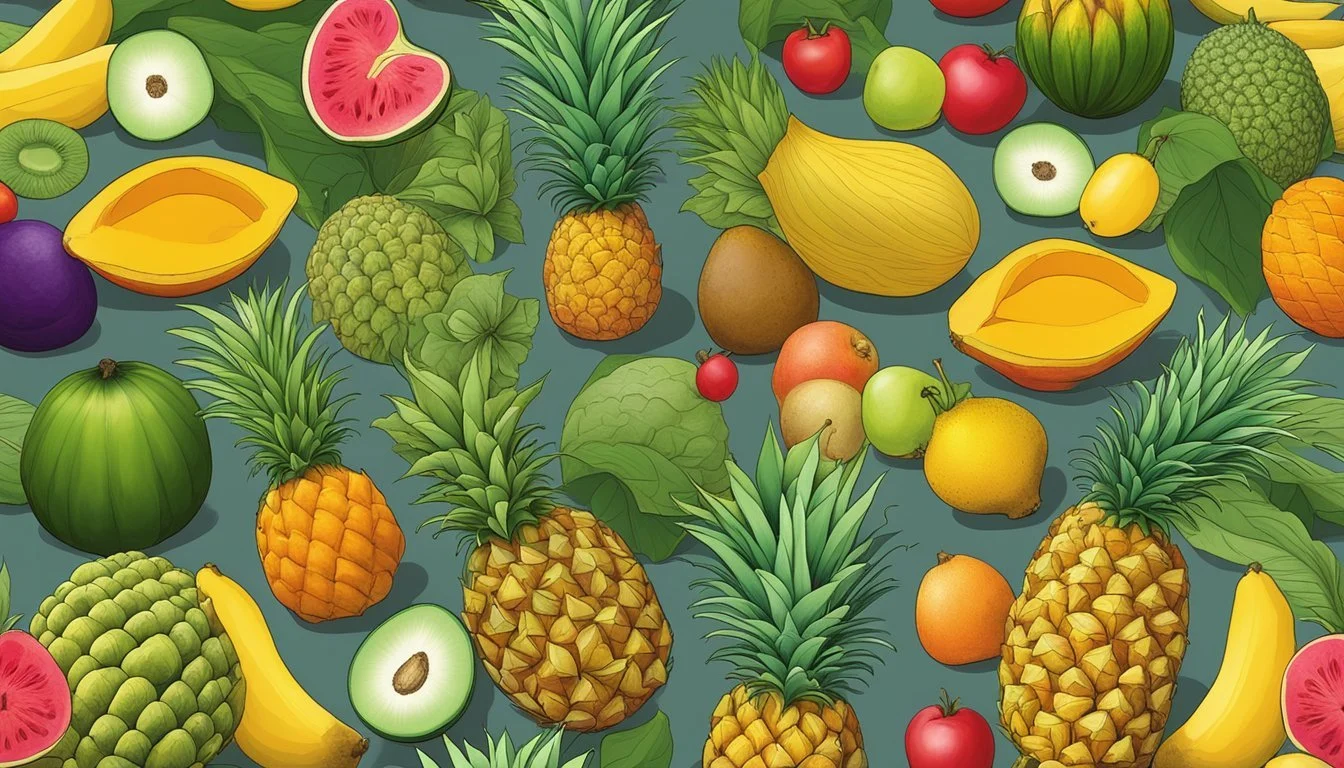Hawaii Seasonal Fruit & Vegetables in March
A Guide to Fresh Produce Selection
This Article is Part of our Hawaii Seasonal Fruit & Veg Calendar
Hawaii's unique tropical climate creates an environment where a diverse range of fruits and vegetables can flourish year-round. Despite this, each month brings its own peak seasons where certain produce is at its best in terms of flavor and nutritional value. March in Hawaii is particularly notable for the transition it brings, featuring the tail end of winter fruits (What wine goes well with fruit?) and the early signs of spring harvests.
During March, visitors and locals can enjoy an abundance of avocados (how long does avocado last?), revered for their rich, creamy texture and versatility. The island's avocado varieties are at their peak of ripeness during this time, making them a perfect addition to salads or as a stand-alone treat. Citrus fruits also continue to be in season, with oranges being especially juicy and abundant.
It is also a prime time for mangoes, which begin to make their appearance in markets and on trees. Recognized for their sweet, succulent flesh, Hawaiian mangoes are highly anticipated and sought after. Meanwhile, vegetables like arugula and lettuce grow well during March's mild temperatures, providing a fresh, crisp base for a variety of dishes. These offerings show the richness of Hawaii's agricultural bounty, allowing residents and visitors to taste the freshest flavors the islands have to offer.
Understanding Hawaii's Growing Season
Hawaii's environment offers a unique agricultural landscape where the growing season extends year-round, thanks to the island's tropical climate and fertile soil. The idyllic weather conditions allow for continuous cultivation, differing vastly from the more defined seasonal changes of the mainland.
March and April in Hawaii mark a transitional period between the late winter and early spring. During these months, a variety of crops reach their peak and are harvested for their freshness and flavor. The islands don't experience a traditional four-season cycle, which typically allows for a diverse array of fruits and vegetables to flourish throughout the entire year.
During the early spring, certain fruits and vegetables are particularly abundant. Locals and visitors alike can enjoy fresh produce that is characteristically more flavorful and nutrient-rich during their natural peak seasons.
Here's a snapshot of what's in season during March in Hawaii:
Fruits:
Avocados: Available from November through February, they might still be found in early March.
Bananas: (how long do bananas last?) June through October, with some varieties available year-round.
Mangoes: Starting as early as March, with the season stretching into November.
Vegetables:
Cabbages: Often found during this time.
Lettuces: Various types continue to grow.
Late winter, which includes January and February, has a similar produce profile to March, with February being the end of the avocado season and the mangoes just starting to come into season in March.
Gardeners and consumers in Hawaii should plan accordingly, as the island's perpetual growing season provides an exceptional opportunity to enjoy a rich array of produce. The key to taking full advantage of Hawaii's growing season is staying informed about what is freshest at any given time.
Seasonal Fruits in March
March in Hawaii brings a refreshing array of fruits to the table, many of which are at their peak of ripeness. Consumers will delight in the tropical flavors and the rich variety of citrus and berries available.
Tropical Delights
In the realm of exotic fruit, March is synonymous with the ripening of several tropical treasures. Banana enthusiasts can enjoy the unique sweetness of the apple banana, a smaller and sweeter relative of the common Cavendish variety. The mango is just beginning to enter its season, offering the early varieties of this luscious fruit. For those seeking a true taste of Hawaiian exotic fruits, papayas are readily available, along with the start of the lychee season.
Mango: Starting to come into season.
Papayas: Continuously in season, fully ripe.
Apple Banana: Available and sweet.
Lychee: Early season varieties.
Citrus Varieties
Hawaii's citrus selection remains varied and vibrant in March. Oranges are still obtainable with full flavors, and one can also find strawberry guava, which combines the essence of strawberries and the tropical zest of guava in one fruit. Lilikoi, also known as passion fruit, is another citrus that can be found, adding tartness and tropical flair to any dish.
Oranges: Plentiful and juicy.
Strawberry Guava: Sweet with a touch of tartness.
Berry Selections
While Hawaii may not be known for traditional berries, it offers the strawberry-like mountain apple. The sugarloaf pineapple, distinct for its sweetness that has been compared to sugarloaf, is a local variety of pineapple that also peaks during this month.
Mountain Apples: Similar to strawberries in sweetness.
Sugarloaf Pineapple: Exceptionally sweet; in season.
Seasonal Vegetables in March
In March, Hawaii's rich volcanic soil and favorable climate contribute to a varied and vibrant offering of vegetables. Shoppers and chefs can find a bounty of fresh produce that includes tender leafy greens, crisp root vegetables, and an array of other delectable vegetable varieties.
Leafy Greens & Salads
Hawaii's gardens yield an abundance of leafy greens in March. Shoppers can expect to find fresh lettuce, kale, and spinach, perfect for salads. Local markets are often stocked with leafy greens that are ideal for creating nutritious dishes.
Root Vegetables
March is also a good time for Hawaiians to harvest a selection of root vegetables. Carrots and radishes thrive in the cool March weather, offering a sweet and spicy addition to meals. Sweet potatoes, a staple in Hawaiian cuisine, are another root vegetable commonly found during this month.
Other Vegetable Varieties
A diverse selection of other vegetables peaks in March. Cabbages are typically quite abundant, offering a substantial base for stews and slaws. Vegetable enthusiasts can also find celery, cucumbers, and eggplant (What wine goes well with eggplant?)available in the local markets. Broccoli and asparagus, known for their health benefits, are also in season, while corn offers its sweet kernels for a variety of dishes.
Farmers Markets and Grocery Store Availability
In March, Hawaii's farmers markets and grocery stores are teeming with a variety of fresh produce. Shoppers can find an abundance of seasonal fruits and vegetables that are freshly harvested and at peak flavor.
Farmers markets are the go-to places for the freshest local produce. They usually offer a wider variety of fruits and vegetables than their grocery store counterparts, including some that are harder to find. For example, the Waimanalo Long eggplant (What wine goes well with eggplant?), a variety that thrives in Hawaii's climate, may be more readily found in farmers markets.
Grocery stores in Hawaii stock up on both local and imported produce. While they do have a selection of seasonal items, the range might not be as extensive as farmers markets. However, grocery stores may provide consistency in availability and convenient access to staple items, like pineapples and other tropical fruits, even if they are not in season locally.
Here's a breakdown of what shoppers might find in Hawaii during March:
Farmers Markets Grocery Stores Waimanalo Long eggplant Pineapples Seasonal tropical fruits (lilikoi) Staple vegetables (e.g., eggplants) Hard-to-find local varieties Imported fruits and vegetables
Remember, the produce availability at farmers markets can be subject to change based on weather and other local factors. In contrast, grocery stores tend to have more consistent stock due to a combination of local and imported goods. Consumers seeking the freshest ingredients should visit their local Hawaii farmers market, while those looking for specific items or year-round availability might find grocery stores more reliable.
Preparing and Cooking Seasonal Produce
In March, Hawaii's bounty of fruits and vegetables can be enjoyed in various forms—from fresh consumption to cooked preparations. Embracing these methods can enhance flavors and provide culinary diversity.
Fresh Consumption
Consuming fruits and vegetables fresh is the simplest way to enjoy Hawaii's seasonal produce in March. Fruits such as persimmons can be eaten raw to appreciate their full, sweet flavor. Vegetables like peas are crisp and can be added directly to salads for a burst of sweetness and a pleasant texture. Coconut water, straight from a freshly cracked coconut, is not only refreshing but also full of nutrients.
Persimmons: Enjoy raw to savor their natural sweetness.
Peas: Add raw to salads for a fresh, sweet crunch.
Coconut Water: Drink fresh for hydration and natural electrolytes.
Cooking Techniques
Cooking allows for a transformation in both texture and taste of Hawaii's seasonal ingredients. Gentle roasting can bring out the natural sugars in vegetables like peas, pairing well as a side dish with roast chicken. Fruits can be added to main dishes to create a unique fusion of flavors; persimmons can be grilled and served alongside savory meals.
Roast Peas: Elevate their sweetness when served with roast chicken.
Grill Persimmons: Pair with savory dishes for a flavor contrast.
Preservation Methods
Preserving the abundance of March produce allows enjoyment beyond the season. Fruits can be transformed into jams or juices, locking in the taste of the season. Vegetables can be processed into spreads such as hummus, incorporated into salsas, or pickled to extend their shelf life and add variety to the culinary repertoire.
Fruits:
Jam: Preserve persimmons or other fruits in a sweet spread.
Juice: Extract the essence of fresh fruits for later enjoyment.
Vegetables:
Hummus: Create a flavorful spread from peas.
Salsa: Combine with spices and other ingredients for a fresh, homemade salsa.
Health Benefits of Hawaii's Seasonal Produce
In March, Hawaii's seasonal produce boasts a variety of fruits and vegetables that are not only flavorful but also packed with health benefits. Citrus fruits like oranges and limes are abundant during this time.
Oranges, a citrus favorite, are celebrated for their high Vitamin C content. This essential nutrient is crucial for the immune system, skin health, and the repair and maintenance of tissues in the body. A medium-sized orange can provide the daily recommended Vitamin C intake.
With their tart and tangy taste, limes add a burst of flavor to dishes and beverages. They not only enhance taste but also contribute a dose of antioxidants. These compounds fight free radicals, which are known to contribute to chronic diseases.
Here's a brief overview of these seasonal offerings:
Fruit Health Benefits Nutritional Highlight Oranges Boosts immune function High in Vitamin C Limes Antioxidant properties Source of antioxidants
Eating these fruits fresh from the local markets allows consumers to enjoy the most intense flavors and highest nutritional value. By selecting fresh, in-season produce, individuals can contribute to sustainability and support local agriculture. The fruits found in March are just a taste of the healthy offerings available from Hawaii's rich volcanic soils, which provide a unique and beneficial growing environment for a diverse range of produce.
Having these fruits in their peak season ensures not only optimal freshness but also maximum health benefits, as the natural ripening process allows for peak nutrient density.
Exploring the Exotic Varieties
Hawaii's climate nurtures a range of exotic fruits, turning a visit to the islands into a journey of taste discovery. Among these, rambutans, passion fruit, and longan stand out for their unique appeal.
Rambutans greet visitors with their hairy exterior, hiding a juicy and translucent flesh inside, reminiscent of a lychee. They thrive in Hawaii's warmth, often found in farmers' markets and local stores.
The passion fruit, known locally as lilikoi, presents a tough outer rind, which can be yellow or purple based on the variety. Inside lies a tantalizing treat — the edible seeds are nestled in fragrant, tart pulp.
Longan, akin to rambutan, offers a distinct experience. It has a more subdued sweetness with a vibrant burst of flavor, making it a favorite for those who seek a less intense but equally exotic taste.
Here's a brief overview of each:
Fruit Appearance Flavor Notes Seasonality Rambutan Red, hairy exterior Sweet, lychee-like Widely available Passion Fruit Yellow or purple skin Tart and fragrant Year-round, with peaks Longan Brown skin, translucent flesh Subtly sweet, aromatic Seasonal availability
These fruits not only tantalize the taste buds but are also integral to the Hawaiian culinary scene. Visitors and locals alike enjoy them fresh or incorporated into various dishes and beverages, further enriching the island's gastronomic heritage.
Sustainability and Local Agriculture
In Hawaii, March marks a period of bountiful seasonal harvests, notably in the fruit sector with mangos and oranges. The shift toward sustainable practices in local agriculture allows for the cultivation of these crops in alignment with the islands' natural growing seasons. This approach ensures that the fruits harvested are not only fresher but also have less environmental impact due to reduced transportation emissions.
Farmers in Hawaii are fostering sustainability by focusing on local food production. This focus benefits the environment by conserving water, minimizing soil degradation, and reducing the carbon footprint associated with shipping imported goods. Local agriculture supports the community by providing jobs and contributing to a self-sufficient food ecosystem.
Here's a glance at the March seasonal harvest:
Mangos – Known for their rich flavor, they are a highlight of the month.
Oranges – Offered locally, they are a staple in many Hawaiian diets during this season.
Promotion of local agriculture in March and other months is essential. It helps to preserve Hawaii's agricultural heritage while responding to contemporary sustainability challenges. Encouraging consumption of locally grown produce aligns with the islands’ goals for climatic resilience and strengthens the link between land and table.
Hawaii's Influence on Global Fruit Trends
Hawaii, often referred to as the Happy State, plays a significant role in shaping global fruit trends. This island chain's tropical climate fosters a rich agricultural environment, allowing a variety of fruits to thrive. Hawaiian fruit trends often reflect the state's unique varieties of produce, which catch the attention of consumers worldwide.
Key Hawaiian Fruits:
Pineapple: Hawaii once dominated the global pineapple industry.
Mango: The diverse mango varieties from Hawaii inspire recipes and dishes globally.
Papaya: Hawaiian papaya, specifically the GMO Rainbow papaya, has set agricultural benchmarks.
Travel to Hawaii often involves experiencing its flavorful fruits, which visitors seek to recreate or find upon returning home. This demand has led to the spread of Hawaiian-inspired fruit products and cultivars in international markets. Cultivation practices from Hawaii also serve as a model for other tropical regions. The trend of farm-to-table dining in Hawaii emphasizes fresh, local produce, further influencing consumer preferences worldwide.
The state's approach to fruit cultivation and marketing combines traditional Hawaiian cultivation techniques with modern agricultural practices. The result is a fruitful yield of high-quality produce, reaffirming Hawaii's status as a trendsetter in the world of fruits. Their strategy influences how fruits are grown, presented, and enjoyed across different cultures, cementing Hawaii's influence on global fruit trends.
Shopping Guide: Selecting the Best Produce
When shopping for Hawaiian produce in March, consumers should look for freshness and quality. Here are some tips for picking the best fruits and vegetables during this time:
Avocados: Seek out avocados that are slightly soft to the touch. Their skin should be free of deep blemishes or cracks.
Bananas: The apple banana variety is popular in Hawaii. Choose bananas that are firm, without bruises. A slight green tinge indicates they will ripen at home.
Limes: Opt for limes that feel heavy for their size, which usually indicates they’re juicy. The skin should be bright and slightly glossy.
Additional Produce to Consider:
Broccoli: Bright green florets and firm stalks are indicators of good broccoli.
Lettuce and Greens: Look for vibrant colored leaves that are crisp, not wilted.
Tomatoes: Should be fragrant and give slightly under pressure, with smooth, tight skin.
For those looking to share their produce finds or seeking inspiration, Pinterest can be a useful platform to find recipes and storage tips.
For convenience, some shoppers may choose to click on affiliate links for recommended products to ensure they have the right tools for storing and preparing their fresh Hawaiian produce.
Remember, selecting seasonal produce not only supports the local economy but also provides a fresher and more flavorful experience.
Cultural Significance of Fruits and Vegetables in Hawaii
In Hawaii, fruits and vegetables are not just food; they represent a deep cultural heritage and play significant roles in both historical and contemporary Hawaiian society. Native fruits like ulu (breadfruit) signify more than sustenance. Ulu has been a staple in the traditional Hawaiian diet and is linked to the mythological story of creation in Hawaiian culture, where it is believed that the ulu tree was created from the severed body parts of a god to feed the people.
Coconuts stand as a symbol of versatility and resourcefulness. Every part of the coconut has a function; the milk and flesh for consumption, the husks for fabric and craft, while the water serves as a hydrating drink. They often feature in rituals and ceremonies and are also used in traditional medicine.
The apple banana, distinct from its continental cousins, is smaller and sweeter, esteemed for its rich flavor. These bananas are often found in backyard gardens throughout the islands, including the Big Island, highlighting the local preference for home-grown, fresh produce.
Hawaiian flora includes an array of flowers with edible seeds that are used in lei-making and adornment, showcasing the connection between agriculture and cultural practices.
Among the varieties of mango cherished in Hawaii, the Hayden and Pirie are particularly prized. Mangos are celebrated through festivals and are considered not just food but a part of the island's identity, bearing a rich history intertwined with the Hawaiian way of life.
This profound connection with the land and its yield is at the heart of Hawaii's food culture, blending the lines between sustenance, tradition, and identity.
Recipes and Pairing Ideas
March in Hawaii offers a bounty of fresh produce perfect for crafting vibrant and flavorful dishes. This section will explore creative recipes and traditional Hawaiian pairings to make the most of the island's seasonal fruits and vegetables.
Tropical Flavors for Your Table
Utilizing March's fresh picks, one can prepare an array of tropical-inspired dishes. For instance, Hawaiian Avocado Toast can start the day with a creamy twist, using locally sourced avocados, which come in three main varieties—Mexican, West Indian, and Guatemalan. Spread on multi-grain bread and topped with thinly sliced Sugarloaf pineapples, it combines healthy fats with a sweet tang.
A refreshing Mango Salad can feature ripe mangoes, a March favorite, along with mixed greens and a passion fruit vinaigrette. The mango's sweetness perfectly balances the tartness of passion fruit. This fruit salad can serve as an energizing lunch or a light dinner, ensuring that the heart of the meal features heart-healthy ingredients.
Ingredient Recipe Idea Bananas Banana Nut Muffins Avocados Avocado and Citrus Salad Sugarloaf Pineapple Pineapple Salsa Passion Fruit Passion Fruit Sorbet
Traditional Dishes
Many traditional Hawaiian dishes can be adapted to include the seasonal produce of March. A classic Poke Bowl, often featuring tuna or other local fish, can be topped with slices of avocado and mango for a creamy and fruity twist—adding both texture and rich flavor to the dish.
For dessert, a Hawaiian Banana Bread can be given a March makeover with the inclusion of fresh bananas and macadamia nuts. The bananas provide natural sweetness and moisture, making the bread a staple in any Hawaiian feast.
Cooking with seasonal ingredients in Hawaii during March not only supports local agriculture but brings the freshest flavors to the table. Incorporating fruits like bananas, mangoes, avocados, and the Sugarloaf pineapple highlights the tropical taste of the islands, while passion fruit adds a zesty accent, ensuring that every dish is as delicious as it is nutritious.
Preservation and Storage Tips
When dealing with seasonal fruits and vegetables in Hawaii during March, proper preservation and storage are vital to prolonging freshness and flavor. Here are some focused tips for specific produce and products:
Fruits like Mango and Lychee:
Refrigerate ripe fruits: Once ripe, they should be kept in the refrigerator to slow down the deterioration process. Lychees can be stored in a plastic bag to retain moisture.
Freezing: For extended preservation, one can peel and cut these fruits into chunks, then freeze them in airtight containers or freezer bags.
Vegetables such as Leafy Greens:
Cool and Moist Storage: Vegetables like lettuce should be stored in the crisper drawer of the refrigerator to keep them fresh and crisp.
Airtight Containers: An airtight container or a sealed plastic bag can prevent wilting and preserve the quality.
Making Jams and Jellies:
Fruits with high pectin (how long does pectin last?) content are ideal for making jams and jellies. Sterilize jars and follow proper canning procedures to ensure longevity.
Store jams and jellies in a cool, dark place. Once opened, refrigeration is necessary.
Using Coconut Milk:
Refrigerate: Coconut milk should be refrigerated if not used immediately and typically remains good for a few days.
Freezing: For longer storage, freezing coconut milk in ice cube trays can be an effective method. Thawed coconut milk is best used in cooked dishes.
General Tips:
Label and Date: Always label and date your preserved items, so you keep track of their shelf life.
Check Regularly: Inspect your stored produce regularly for signs of spoilage such as mold or unpleasant smells.
By following these guidelines, one ensures that the seasonal bounty remains delicious and safe for consumption long after its peak season.














